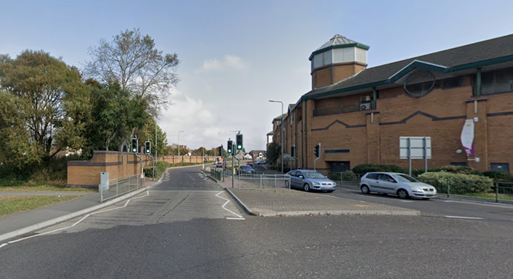What are the impacts of transport planning on place? In this blog, David Fevyer explores how mobility (and limited mobilities) can shape, transform and reimagine physical neighbourhoods and a place’s sense of self.
When we think about towns as places – and the spaces within those places – it is impossible to avoid thinking about how we move around them. How we perceive a place is marked by how we can move through it: the mode of transport we use, the routes we take, and the effect of our individual and collective movements on the character and feel of the public spaces we encounter. Mobility shapes both our literal and imaginative journeys through and between places. But it also shapes the places themselves. The decisions that are made about how people will get around – by planners, politicians, and even individuals – shapes the very material structure of our urban environment.
Spazieren in Boscombe
During a recent online exercise led by Michelle Rumney, participants were invited to draw a linear map of a journey – real or imagined – between two places within the case study town of Boscombe. One of the things that struck me about this engaging and thought-provoking exercise was not just that it involved a journey – an act of mobility – but also that it was a walking journey. This meant that it could be slow enough to take in both large and small aspects of the places journeyed through, and because it did not involve being inside a vehicle also gave rise to potential interactions and encounters with the environment and other people. Walking also meant being able to take certain routes, to traverse individual and perhaps otherwise hidden geographies, as one participant put it. But walking also meant feeling differently about some routes, or even avoiding them. Fear of traffic violence, aversion to traffic noise and pollution, and concerns of social safety in spaces dissected and abandoned by transport infrastructure, colour feelings towards a space and can even foreclose some ways of traversing it.
Looking at my own map, I realised I had written ‘traffic panic’ next to the hill I’d walk down to reach the top of Boscombe Chine Gardens. And I wondered: is this an expression of the experience of walking, or of the space itself? Of a relationship with Boscombe or with cars or with other people? Am I alienated from a place I have known since childhood, travelling there by bus with my gran from her flat in Southbourne in the 1980s? If so, is that because there is something different about the space now, or something specific to the context of a global pandemic? Or am I just a 42-year-old with deep-rooted worries about pollution, car dependency, and climate change?


‘Traffic Panic’ on the way to Boscombe Chine Gardens.
(Bottom Image: Google Streetview)
It may be several or all of these things. But in as much as it was a personal experience, it was also embedded in transport choices. Different modes of transport – walking, cycling, driving, taking the bus – produce different experiences of places because they compress or expand space and time; open, close, or complicate different routes; frame interactions with others using the same and different modes, and mediate the experience of the spaces themselves. Importantly though, this is not an entirely personal process shaped only by an individual’s own choice; the movement of others and the structure of the places themselves also shape and are shaped by those choices and their consequences.
In transport studies, we talk about how individual and collective transport choices impose themselves on others, and how this relationship is not equal but rather traces many of the familiar contours of wider inequalities. The classic formulation of this is that those ‘least travelled’ are also those ‘most travelled upon’; that groups and individuals who are less able to travel also ‘carry a greater burden of the costs of other people’s travel’ (Sustainable Development Commission, 2011).
We can see this relationship in action in Boscombe. When the Sovereign Centre retail development took place in 1990, it involved the re-routing of the A35 around the north of the new development. This allowed the old Boscombe high-street to be pedestrianised, but also necessitated the compulsory purchase and demolition of further houses. It also created a hostile road environment for anyone travelling by non-motorised means from the northern part of Boscombe to the new Sovereign Centre and old high-street. Suddenly this required you to cross a wide and fast-flowing road at one of two prescribed locations – one of which is an underpass with poor sight lines and associations of social danger. So whilst the new road ostensibly enabled greater mobility in the area and served as access to the Sovereign Centre’s car park, much of its capacity was actually for the benefit of people passing through Boscombe from somewhere else to somewhere else by car. Meanwhile the new road also acted – and still acts – as a form of barrier for anyone who walks or cycles the short route to the highstreet from north Boscombe. Those without access to one mode of transport (and 53% of households in that part of Boscombe have no car or van) are nevertheless ‘travelled upon’ by the individual and collective choices of those who do have such access.

Roads as barriers: The A35 cuts through the space between housing on the left and the Sovereign Centre to the right. The long wall, strategically planted bushes, and ‘cattle grid’ fencing enforce compliance with the two prescribed crossing points. (Image: Google Streetview)
Transport and Places – Two sides of the same town
The example of the A35 scheme around Boscombe’s Sovereign Centre touches on several key intersections between how the places in towns are shaped and given form, and the transport decisions that these places in turn shape and are shaped by. When we talk about enabling connectivity and cohesiveness in a place, we must be mindful that these things can be simultaneously made or broken by transport – that which connects for some can sever for others. Even the same person can be enabled to make some forms of connections whilst being prevented from others: it can become easier – and seem safer and more pleasant – to drive to an edge-of-town shopping centre than to walk 10 minutes to your local highstreet. Meanwhile, transport planning’s traditional focus on the 9-5 commuter (which actually only accounts for 20% of all journeys) has long been recognised as skewing the spatial and infrastructural forms of towns towards benefits disproportionality accrued by specific age, gender, socio-economic, and cultural groups. And this isn’t just about the roads and pavements themselves – whilst Boscombe’s Sovereign Centre and A35 diversion/barrier was being built, Boscombe hospital was being run down and eventually closed. In a mirror of retail’s shift away from local highstreets, people in Boscombe instead became dependent on motorised transport to the edge-of-town Bournemouth Hospital.
So transport not only shapes how we move, but also what kind of connections, opportunities, and relationships are available to us. And there are important and urgent questions about how transport policy decisions affect individual and community connections.
Similarly, the unfolding of a ‘sense of place’ is mediated by transport. When the urbanist Luca Bertolini describes the ‘node-place’ model, he draws attention to the tensions that can arise between a location’s place and transport functions. An over-stressed transport function can be associated with undermining (or un-making) a place. The ‘flows’ of people through a place – how they overlap (or don’t), bring different people together (or don’t), and draw people into places (or don’t) appear as critical questions in how successfully a town can enable a vibrant and diverse cultural life (or not). Recognising the importance of transport – in particular individual mobilities beyond, across, and outside the 9-5 motorised commute – is necessary for planning for a creative economy, and for attracting and retaining the diversity of uses and people needed to revive our depleted town centres.
Critical Perspectives on Mobility
When we talk about how the Towns Fund has allied economic indicators and priorities with ideas such as ‘civic identity’, ‘bringing people together’ and a sense of pride in places, we’re drawing attention to how government investment lays claim to social goods beyond the financial bottom line. Transport investment is also similarly positioned as enabling wider benefits for the liveability, sustainability, and ‘sense’ of places. In both cases, the reality is often not straightforward, with policies driven by quite narrow economic interests and assumptions often failing to deliver the public benefits to people’s health and wellbeing, or to address issues of social justice, accessibility, economic inequalities, and environmental sustainability. Seeing our towns through a narrow or mono-modal experience of mobility is one part of this problem. Conversely, experiencing these environments through different modes, at different scales of space and time, and across different flows and geographies reveals diverse and often hidden needs and opportunities for individuals and communities. Giving voice to these different mobility experiences and the people that have them is a potentially transformative approach to the rejuvenation of towns. It is also something that our cultural critical and creative disciplines are uniquely positioned to contribute to.
David Fevyer has interests in both English literature and active travel. His doctoral thesis at the University of Southampton examined climate change in contemporary fiction. After several years of local active travel advocacy work in Bournemouth he completed an MSc in Transport Planning and Management at the University of Westminster. His dissertation focused upon how fatal road collisions are reported in newspaper coverage. His current research interests include the cultural and media representations of active travel modes and how these influences public understanding and political action, and the potential for inter-disciplinary conversations between cultural criticism and transport studies.



